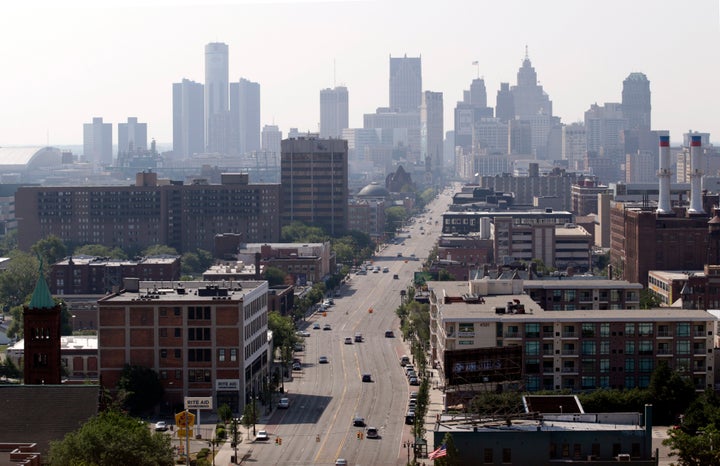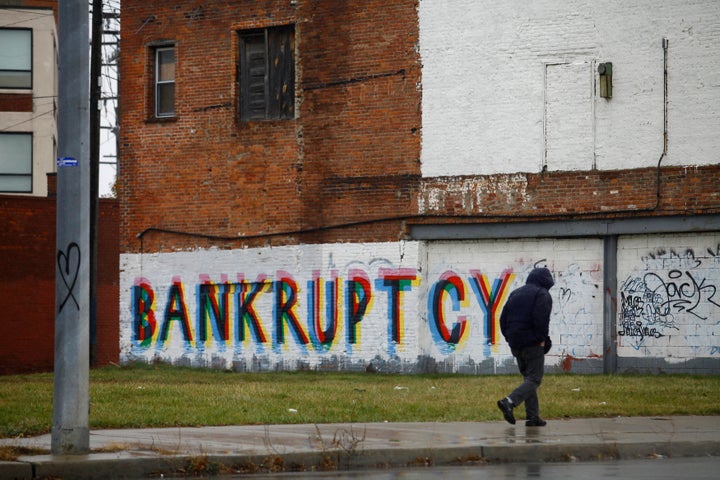Detroit’s historic bankruptcy was complex and unique -- but it offers some surprisingly universal lessons for anyone who struggles with money.
When the city announced it was broke in 2013, its budget was crippled by declining revenue stemming from population loss, the financial crisis and disinvestment from the state. At the same time, officials made avoidable mistakes, according to Nathan Bomey, author of Detroit Resurrected: To Bankruptcy and Back.
Bomey, a USA Today reporter, covered the bankruptcy trial for the Detroit Free Press. Released last month, his book takes a behind-the-scenes look at how major players engineered an agreement that cut pensioner benefits, settled with creditors, and secured hundreds of millions in aid from foundations and the state. The city emerged from Chapter 9 bankruptcy in 2014, shedding $7 billion in debt.
While the bulk of Detroit Resurrected tracks the dramatic bankruptcy trial and tense closed-door negotiations, Bomey also clearly charts the financial missteps from the previous decade that helped put Detroit on a path to insolvency.
He occasionally puts them in familiar terms. One deal is compared to putting monthly expenses on a credit card; another to “a toxic mortgage that could not be refinanced.”
Detroit Resurrected isn’t intended to be a personal finance guide. But it reminded me of some of the financial mistakes I’ve made, and the difficult task of getting one’s finances back on track.
Here are a few of Detroit's money mistakes to avoid, and a couple decisions worth emulating.

There are no simple fixes for financial shortfalls, and borrowing now can can cost big later.
The “point of no return” for Detroit was an inventive and irresponsible borrowing scheme the city cooked up in 2005, according to Bomey. Under then-Mayor Kwame Kilpatrick, the city borrowed $1.44 billion to plug a huge hole in the pension funds. Only a few years later, the city risked defaulting and negotiated an even worse deal.
The one-time fix let political leaders avoid making unpopular but necessary cuts at the expense of the city’s future financial health, Bomey argues.
“What they did in 2005 was refuse to make the tough decisions that they needed to make to protect the city's retirees and to ensure that the budget was balanced,” he said.
Likewise, financial experts discourage individuals from taking on long-term debt for anything other than big expenses that have a potential return, like a mortgage or student loan.
Just because you qualify for a loan doesn’t mean it’s a good idea.
While the Kilpatrick deal looks like a terrible bet in hindsight, at the time it was heralded by city officials and Wall Street. Banks were all too willing to help Detroit borrow exorbitantly, whether or not it was fiscally responsible.
Bomey sees parallels to banks’ loosened restrictions for homeowners.
“In that era, Wall Street was lending money to homeowners who couldn’t afford to borrow, so it should come as no surprise that they were also willing to lend to a city that couldn’t afford to borrow,” Bomey said.
“This was like a subprime loan on steroids,” he writes in Detroit Resurrected.
You can’t fix financial problems until you own up to them.
The way Bomey tells it, Kilpatrick’s borrowing scheme was a way of hiding the extent of Detroit’s financial problems.
“Kwame Kilpatrick refused to tell [pensioners] the truth, which is that they couldn’t afford to pay certain benefit levels anymore, and instead we just lied to retirees for years,” he said.
When the moment of reckoning came, the problem had only gotten worse and pensioners were shocked by the proposed cuts -- the equivalent of a woman finding out her husband had racked up to $80,000 in credit card debt to keep up their lifestyle after he took a pay cut.
It’s not uncommon for people to hide their money troubles from their family. A third of people with combined finances admitted to lying to their partner about money, according to a 2014 survey of 2,035 adults conducted by the National Endowment for Financial Education.
Paying only the minimum on debt exacerbates the problem.
It might seem responsible to faithfully pay the minimum on a credit card balance each month, but you’re actually losing money and keeping yourself trapped in debt. According to debt management site Ready for Zero, it could take over five years to pay off $1,000 if you're just paying the minimum, and you’d spend $566 on interest alone.
Detroit took a similar approach. After borrowing $1.44 billion, the city only made payments on the accumulating interest for years.
“That deferred the pain temporarily but only made things worse when the city finally went broke,” Bomey said.
Plan for the future -- and expect the worst.
Detroit made a smart move during bankruptcy when it determined what return rate to expect from pension fund investments, Bomey said. They settled on 6.75 percent, one of the lowest rates in the country.
“A responsible family is going to manage their budget with relatively conservative expectations, and if you have a surplus at the end, great,” Bomey said. “If you take an irresponsible approach and expect more money to come in than eventually comes in, then you have to adjust your budget. And that can be very painful.”
Balance paying debt with investing in the future.
If you’re trying to eliminate debt, it can be tempting to cut expenses to the bone and put every penny possible toward your balance. But in many cases, it’s smart to continue saving money for emergencies and retirement to guarantee future financial well-being.
Until bankruptcy, Detroit was putting little money toward maintaining or improving city conditions -- four out of every 10 budget dollars were going toward debt, pensions and health care benefits for retirees, and that figure was set to rise to seven out of 10 by 2020.

The city was beset with problems like the fire department’s malfunctioning emergency alert system. Bomey describes one station where firefighters rigged a replacement system using a fax machine that would print notifications, knocking a soda can over. A lack of basic services was one of the factors driving out residents: Garbage collection was irregular, 40 percent of the city's street lights were out and police response times were nearly triple the national rate.
The bankruptcy agreement was designed to allow Detroit to spend money on the essentials that allow residents to have a decent quality of life -- and will stabilize the city in the future.
“They are reinvesting in raises for police officers, new fire equipment, new buses, basic technology like software systems in the city that they need to improve tax collections,” Bomey said. “Bankruptcy is the first moment Detroit finally put its people before its creditors.”

